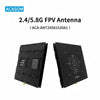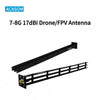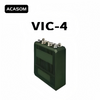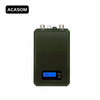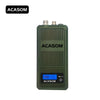Struggling with Helium Network Interference? How a 915MHz Cavity Filter Can Fix Your Signal Issues
Introduction
In the rapidly expanding world of IoT (Internet of Things) and decentralized networks like Helium and LoRaWAN, maintaining a clean and interference-free RF signal is critical. One of the most effective ways to ensure optimal performance is by using a 915MHz cavity filter.
This guide explores why high out-of-band rejection filters are essential, how they work, and their crucial role in Helium mining, LoRa sensors, and industrial IoT applications. We’ll also break down the technical specifications of a premium 915MHz cavity filter with SMA-female connectors, helping you make an informed decision for your RF system.
Why Out-of-Band Rejection Matters
The Problem: RF Interference in Crowded Networks
Wireless signals in the 902-928MHz ISM band (used by Helium and LoRa) often face interference from:
-
Nearby transmitters (Wi-Fi, Bluetooth, cellular signals)
-
Unwanted harmonics from other devices
-
Environmental noise (industrial equipment, power lines)
Without proper filtering, this interference can lead to:
✔ Data packet loss
✔ Reduced network range
✔ Unstable Helium mining rewards
What Makes a Good Filter? High Out-of-Band Rejection
A true RF filter must do more than just allow signals to pass—it must block unwanted frequencies effectively.
-
Out-of-band rejection measures how well a filter suppresses signals outside its intended range.
-
A high-quality 915MHz cavity filter should offer ≥60dB suppression just 10MHz outside the target band.
-
Cheap or poorly designed "filters" may claim low insertion loss but fail to block interference—essentially acting as expensive transmission lines rather than real filters.
Key Takeaway: If a filter doesn’t specify its out-of-band rejection, it’s likely ineffective.
915MHz Cavity Filter: Technical Deep Dive
1. Core Specifications
| Parameter | Specification |
|---|---|
| Frequency Range | 902-928MHz (26MHz bandwidth) |
| Insertion Loss | ≤1.0dB (ultra-low signal degradation) |
| Out-of-Band Rejection | 60dB @ ±10MHz |
| Connectors | SMA-female (input & output) |
| Construction | Rugged aluminum housing (indoor use) |
| Surge Protection | DC short circuit protection |
2. Key Features Explained
A. Ultra-Low Insertion Loss (1.0dB)
-
Ensures minimal signal weakening as it passes through the filter.
-
Critical for long-range LoRa sensors and gateway efficiency.
B. Strong Out-of-Band Rejection (60dB)
-
Blocks nearby signals (e.g., 900MHz GSM, 868MHz EU LoRa).
-
Prevents network congestion in Helium deployments.
C. SMA-Female Connectors
-
Standardized RF interface for easy integration.
-
Secure connections reduce signal leakage.
D. Rugged Aluminum Housing
-
Durable construction for indoor industrial environments.
-
Shields against EMI (electromagnetic interference).
E. Surge & Lightning Protection
-
Built-in DC short-circuit protection safeguards against power surges.
Applications in Real-World Networks
1. Helium Network Gateways
-
Problem: Helium hotspots often suffer from nearby RF noise, reducing Proof-of-Coverage (PoC) rewards.
-
Solution: A 915MHz cavity filter cleans the signal, improving:
-
Data transmission reliability
-
Mining efficiency
-
2. LoRaWAN IoT Systems
-
Use Cases:
-
Smart agriculture (soil sensors, livestock tracking)
-
Industrial monitoring (factory equipment, tank levels)
-
-
Benefit: Fewer lost packets = more accurate data.
3. Industrial & Urban IoT Deployments
-
Factories, warehouses, and smart cities face heavy RF congestion.
-
A high-rejection filter ensures stable LoRa/Helium signals despite interference.
How to Choose the Right 915MHz Filter
1. Verify Out-of-Band Rejection
-
Minimum requirement: ≥50dB suppression at ±10MHz offset.
-
Premium choice (like this filter): 60dB+ rejection.
2. Match Frequency Range
-
Helium/LoRa in the US: 902-928MHz.
-
EU/Asia models: Check for 868MHz or regional ISM bands.
3. Check Connector Compatibility
-
Most gateways use SMA-female or N-type connectors.
-
This filter uses SMA-female on both ports for easy installation.
4. Assess Environmental Needs
-
Indoor use: Aluminum housing (like this model) is sufficient.
-
Outdoor use: Requires IP-rated waterproofing.
Installation Tips for Helium & LoRa Systems
-
Place the filter between the antenna and gateway.
-
Antenna → Filter → Helium Hotspot/LoRa Gateway.
-
-
Ensure tight SMA connections to prevent signal loss.
-
Avoid bending RF cables sharply (can cause impedance mismatch).
-
Test signal strength before/after installation (e.g., using a spectrum analyzer).
Conclusion: Is a 915MHz Cavity Filter Worth It?
If you’re running Helium miners, LoRaWAN sensors, or industrial IoT networks, a high-quality 915MHz cavity filter is a must-have.
✅ Eliminates interference (60dB out-of-band rejection)
✅ Minimal signal loss (just 1.0dB insertion loss)
✅ Durable & easy to install (SMA-female connectors)
For optimal network performance, don’t settle for weak filtering—choose a proven cavity filter like the one described here.
Need one for your setup? [Check our recommended filters here].

